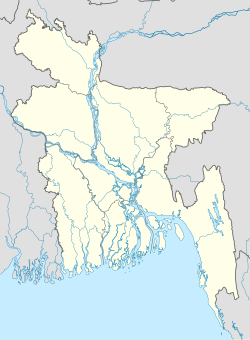Patiya
|
Patiya পটিয়া |
|
|---|---|
| Upazila | |
| Location in Bangladesh | |
| Coordinates: 22°18′N 91°59′E / 22.300°N 91.983°ECoordinates: 22°18′N 91°59′E / 22.300°N 91.983°E | |
| Country |
|
| Division | Chittagong Division |
| District | Chittagong District |
| Area | |
| • Total | 316.47 km2 (122.19 sq mi) |
| Population (1991) | |
| • Total | 398,836 |
| • Density | 1,300/km2 (3,300/sq mi) |
| Time zone | BST (UTC+6) |
| Website | Official Map of Patiya |
Patiya (Bengali: পটিয়া) is an Upazila of Chittagong District in the Division of Chittagong, Bangladesh.
During the British rule, a police station was established in Patiya in 1845. It was upgraded to an upazila in 1984. The region saw revolutionary activities in the 1930s, when revolutionaries from Jugantar and the fugitives of the Chittagong armoury raid fought with British police. During the Bangladesh Liberation War, the area sustained heavy bombings from Pakistan Air Force. The Pakistani occupation army massacred more than 300 Hindus in Muzaffarabad village on May 3, 1971 in collaboration with the Razakars.
Patiya is located at 22°18′00″N 91°59′00″E / 22.3000°N 91.9833°E . It has 70,218 households and a total area of 316.47 km².
According to the 1991 Bangladesh census, Patiya had a population of 398,836. Males constituted 52.1% of the population, and females 47.9%. The population aged 18 or over was 197,399. Patiya had an average literacy rate of 44.3% (7+ years), against the national average of 32.4%.
Patiya has 22 Unions/ Wards, 136 Mauzas/Mahallas, and 124 villages. The township of Patiya has an area of 9.96 km². It is divided into 9 wards and 9 mahallas.
Chairman:Professor Mozaffar Ahmed from BNP,
Vice Chairman: Syed yar Mohammad Peyaru,
...
Wikipedia

